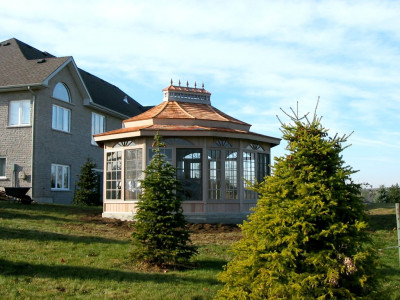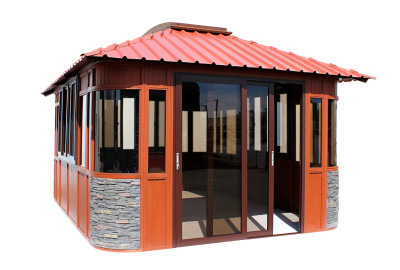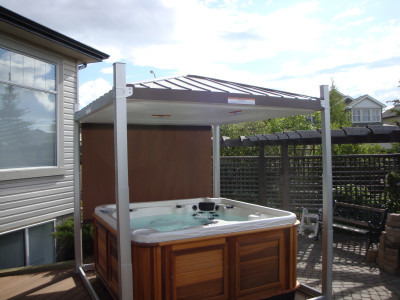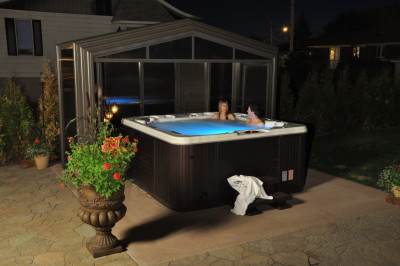Hot tub enclosures
by Sally Bouorm | August 1, 2010 8:57 am
 [1]
[1]By Jason Cramp
They go by many names—gazebos, cabanas, cupolas, pergolas or pavilions—and are made out of everything from wood, metal and glass to fabric and composites. However, no matter what hot tub enclosures and their components are called or constructed of, these structures can help create an ideal backyard getaway—a home away from home.
Privacy and protection
 [2]
[2]Whether it is a cedar gazebo or a glass pergola, enclosures offer several benefits to both the hot tub itself and its owners. The main selling features of an enclosure are the protection they offer bathers from the elements, whether it is windy, raining or even snowing, and the privacy they provide from neighbours.
“Hot tub enclosures are entirely weather-proof, keeping out all elements, and they provide complete privacy,” says Casey Loyd, president of Cal Spas in Pomona, Calif. “As such, consumers are now looking for complete finished enclosures, rather than open-lattice designs.”
David Martin of Dundalk Enterprises in Dundalk, Ont., agrees.
“Most consumers prefer to have an enclosure that can be completely closed in, with the option to open it up,” he explains. “This can be done with sliding windows that have screens to protect bathers from insects, or by using a unique shutter system to allow air to circulate, while providing a high level of privacy.”
According to Martin, ‘The Islander,’ is the company’s most popular enclosure, which offers screened windows that can be opened on warm evenings or remain closed for comfort and privacy. An acrylic skylight allows bathers to sit back and gaze at the stars on quiet evenings with the family.
Go big or go home
A current trend manufacturers have noticed is the consumer’s preference for larger enclosures, which are essentially used as an additional living space. These sizeable structures provide room for outdoor gatherings and dining, or even a quiet place to read a book.
“Outdoor rooms are the biggest trends in the hot tub enclosure market because they add value to the home and can be used year round,” Loyd says.
For example, Cal Spas’ new ‘Tuscany’ enclosure, which is available in 3 x 3-m (10 x 10-ft) and 3.6 x 3.6-m (12 x 12-ft) footprints, is quickly gaining popularity, according to Loyd. A homeowner who adds this type of enclosure to their backyard gets the same results as if they added an entire room to their home, without adding to the home’s square footage.
Another recent design trend Martin has noticed is the increased number of enclosures with a tropical look.
“Palm thatch on gazebos brings the tropical feel to any backyard, a feeling we all enjoy,” he says. “We can’t all spend our vacations in the tropics, so why not in your backyard?”
 [3]
[3]Glass cupolas can offer the best of both worlds when it comes to extending the bathing season and providing additional living space. These enclosures often feature copper roofs and sliding screen windows, creating a focal point in the backyard. The ‘Glass House’ enclosure from Limestone Trail in Beamsville, Ont., has full horizontal, sliding screened windows, which allow breeze and natural light to filter through the room while keeping insects out.
“The primary hot tub enclosures in the past were the lip-mount style, or the kind that provided just enough room to get around the hot tub for service and maintenance purposes,” explains Wanda Searle, Limestone Trail’s sales administrator. “A glass cupola provides space for seating, with enough room for two or three chairs, including a bar fridge or even a small bar. Thus, a pleasant space can be created for family and friends to sit and visit, whether they wish to be in the hot tub or lounging nearby.”
Socializing around the spa
Arctic Spas in Thorsby, Alta., has also picked up on this trend, noting consumers are using their enclosures not only to enhance the soaking experience, but also create a place for relaxation and socializing with friends.
 [4]
[4]Today there are more two-career families than ever before, which has influenced how family members spend their time. According to a 2005 report by Human Resources and Skills Development Canada (HRSDC) titled, Indicators of Well-being in Canada, between 1998 and 2005, the average time Canadians spent on leisure activities decreased from 5.8 to 5.5 hours (18 minutes) per day. Time spent socializing also decreased approximately 1.5 hours per week during this same period.
“Our biggest selling enclosure is our 3 x 3-m (10 x 10-ft) ‘Entertainer’ model,” says Arctic’s Brent Macklin. “It features two enclosed sides to offer some wind protection and privacy, while a third side is equipped with a full cedar bar and the fourth is open. This semi-enclosed version seems to be a good seller as it gives some protection from the elements, but still leaves two sides open.”
Canadian Spa Company in Oakville, Ont., offers a similar design for those who do not want to be completely closed in. The company’s ‘Frazer’ gazebo features two louvered-panel half-walls, a sit-up bar and an open side.
“One of the best features of this gazebo is people can sit at the bar and be part of the spa experience,” says the company’s founder, Troy Labelle.
Low maintenance a key feature
With little time to spend on upkeep, most consumers seek out maintenance-free enclosure options, including those built with non-traditional materials.
“Many consumers are opting to purchase composite hot tub enclosures over real wood structures,” says Lorenzo Sobarzo, sales manager for Alliance Woodcraft in Delta, B.C. “Prior to this, most people would only purchase wooden enclosures, as composite material looked very plastic. Now, some people can not tell the difference.”
 [5]
[5]These design characteristics are what have made Alliance Woodcraft’s ‘Whistler Series’ enclosures appealing to consumers. Available in a 3.6 x 4.8-m (12 x 16-ft) size, its body is constructed of a composite material resembling wood and offers a far greater lifespan. It includes a thermoplastic roof with skylight, large rounded corners and six, sliding tempered-glass lockable windows. The entrance comprises lockable sliding, patio-style doors made of heavy-duty aluminum and tempered glass.
Ernie Sears with Backyard America Outdoor Structures in Manassas, Va., has seen increased interest in their low-maintenance pergolas as well. These structures, including the company’s Potomac series, are constructed much like their wooden counterparts; however, all components are made of vinyl, eliminating any worries of rot or paint. These pergolas are flexible in design and can be built in various sizes, from 1.8 x 1.8 m (6 x 6 ft) up to 9 x 45.7 m (30 x 150 ft).
“When combined with the new fixed canopy system we recently introduced, which is perfect for all types of pergolas, it can block 99 per cent of ultraviolet (UV) A and B radiation, while also providing shade and shelter for bathers,” Sears says.
More than meets the eye
 [6]
[6]Homeowners are also looking for enclosures that can provide more than just shelter from a storm; they want a full package. The ‘Covana,’ from Sterling Leisure Products in Calgary, Alta., is a unique automated hot tub cover, which automatically elevates and lowers via turn-key operation to serve a dual purpose. Not only does it provide considerable energy savings by reducing water loss through evaporation, when raised to its full elevated height (2.6 m [8.5 ft]), its pitched-roof design also sheds rain and snow and provides a gazebo-like environment.
“Owners of hot tubs find their traditional covers become very heavy and difficult to remove and would still like some sort of protection from the elements,” says Louise Piché, Sterling’s operations manager. “The Covana offers both—a cover with an R21 insulation value and a gazebo with optional shades and/or screens for user privacy.”
 [7]
[7]SP International Inc., in Longueuil, Que., also offers a unique enclosure. Its ‘Sparium’ model features a retractable telescopic design, which allows bathers to enclose their hot tub in a matter of seconds to provide shelter and privacy from the elements. Its thermo-lacquered aluminium structure and polycarbonate panels allow the enclosure to withstand harsh climates and its sliding system does not require ground tracks to be installed to facilitate opening and closing.
Manufacturers say most homeowners who own both a hot tub and enclosure purchase them as a set, which is why dealers should use the appeal of a combined package to sell both products.
“Dealers are guaranteed more profit if they add hot tub enclosures to the product lines, since they now have the option of offering complete value-added spa packages to their customers,” Cal Spas’ Loyd explains.
Another benefit according to Arctic’s Macklin: retailers that offer both products are better able to provide their customers with a ‘one-stop shop.’
“If a dealer is working on a hot tub sale and they can offer a complete package by adding some accessories, such as an enclosure, at a good package price, it often encourages the customer to buy the entire package,” he explains.
- [Image]: http://poolspamarketing.com/wp-content/uploads/2010/08/CalSpas_CAL-SPAS-DAY-4-part-2-001877.jpg
- [Image]: http://www.poolspas.ca/wp-content/uploads/2015/07/Dundalk_Bs-Bar-002-crop-A.jpg
- [Image]: http://www.poolspas.ca/wp-content/uploads/2015/07/Limestone_Trail_Stretch-glasshouse_HR.jpg
- [Image]: http://www.poolspas.ca/wp-content/uploads/2015/07/Canadian_Spa_Co_Gazebo_Free_Standing.jpg
- [Image]: http://www.poolspas.ca/wp-content/uploads/2015/07/Alliance_Woodcraft_Whistler-1216.jpg
- [Image]: http://www.poolspas.ca/wp-content/uploads/2015/07/Sterling_Leisure_DSC00821.jpg
- [Image]: http://www.poolspas.ca/wp-content/uploads/2015/07/SP_International_DSC_0305_05.jpg
Source URL: https://www.poolspamarketing.com/trade/hot-tub-enclosures/